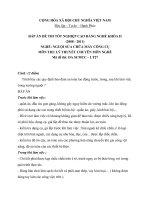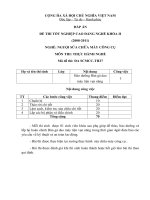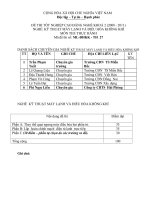CHAPTER 27
Bạn đang xem bản rút gọn của tài liệu. Xem và tải ngay bản đầy đủ của tài liệu tại đây (512.75 KB, 6 trang )
Chapter 27/The Basic Tools of Finance 159
Chapter 27
The Basic Tools of Finance
1.
The amount of money that someone would pay today for the right to receive a future payment is
called the
a. present value of the future payment.
b. determinate value of the future payment.
c. market interest rate.
d. principal.
2.
Which of the following changes would increase the present value of a future payment?
a. a decrease in the size of the payment
b. a decrease in the certainty of the payment actually being received
c. an increase in the amount of time that elapses before receiving the payment
d. a decrease in the interest rate
:
3.
You have a bond that you can redeem for $10,000 one year from now. The interest rate is 10 percent
per year. How much is the bond worth today?
a. $9,091.01
b. $10,000.00
c. $8,264.46
d. 9,523.81
4.
A snowplow will generate a net income of $2,000 per year for its owner. After 8 years, the plow
will break down and have zero value. The maximum amount of money anyone would pay for the
plow is
a. less than $2,000.
160 Chapter 27/The Basic Tools of Finance
b. $2000.
c. between $2,000 and $16,000.
d. $16,000.
5.
You have a choice among three options. Option 1: receive $900 immediately. Option 2: receive
$1,200 one year from now. Option 3: receive $2,000 five years from now. The interest rate is 15%
per year. Rank these three options from highest present value to lowest present value.
a. Option 1; Option 2; Option 3
b. Option 3; Option 2; Option 1
c. Option 2; Option 3; Option 1
d. Option 3; Option 1; Option 2
6.
Someone who cares only about expected return and doesn’t worry about risk is someone who is
a. risk averse.
b. risk neutral.
c. risk seeking.
d. irrational.
7.
Diversification has the advantage of
a. reducing expected return.
b. reducing actual return.
c. reducing risk.
d. reducing the profits of insurance companies.
8.
To diversify, a homeowner with a variablerate mortgage should choose investments that
a. pay higher returns when interest rates rise and lower returns when interest rates fall.
b. pay lower returns when interest rates rise and higher returns when interest rates fall.
Chapter 27/The Basic Tools of Finance 161
c. provide a higher return than the market average.
d. provide a lower return than the market average.
9.
Rex is a mortgage broker, who is paid by commission. When interest rates decline, he does a lot of
business and earns a lot of money, as more people buy houses or refinance their mortgages. But
when interest rates rise, business falls substantially. To diversify, Rex should choose investments
that
a. provide a higher return than the market average.
b. provide a lower return than the market average.
c. pay higher returns when interest rates rise and lower returns when interest rates fall.
d. pay lower returns when interest rates rise and higher returns when interest rates fall.
10.
A person is risk averse if he or she
a. prefers a riskier income, holding fixed its expected value.
b. doesn’t care about the riskiness of income.
c. prefers a lessrisky income, holding fixed its expected value.
d. refuses to diversify risk.
11.
When an agent lacks an incentive to promote the best interests of the principal, and the principal
cannot observe the actions of the agent, there is said to be
a. an optimal contract.
b. diversification.
c. moral hazard.
d. idiosyncratic risk.
:
12.
:
Steve bought fire insurance for his house for an amount that was greater than his house was worth,
then became careless about leaving burning cigarettes around. This is an example of
a. an optimal contract.
b. diversification.
c. moral hazard.
d. aggregate risk.
162 Chapter 27/The Basic Tools of Finance
13.
Adverse selection occurs when
a. sellers have relevant information about some aspect of the product’s quality that buyers lack
(or vice versa).
b. an agent lacks the incentive to act in the best interests of the principal and the principal cannot
observe the actions of the agent.
c. a principal and an agent reach an agreement that maximizes the principal’s profit while
providing an incentive for the agent to participate.
d. a principal obtains information about an agent’s actions.
14.
The fact that someone with a high risk of medical problems is more likely to buy a lot of health
insurance is an example of
a. adverse selection.
b. monitoring.
c. moral hazard.
d. an optimal contract.
15.
Diversification can eliminate
a. all types of risk.
b. idiosyncratic risk but not aggregate risk.
c. aggregate risk but not idiosyncratic risk.
d. all types of risk but only if insurance is purchased.
16.
Bonds are preferred to stocks by individual investors who
a. need to have immediate access to their money.
b. don't think the business is profitable.
Chapter 27/The Basic Tools of Finance 163
c. prefer a guaranteed lower return to a risky higher return.
d. prefer a risky higher return to a guaranteed lower return.
17.
Corporate profits that are not reinvested in the corporation are distributed to
a. consumers in the form of lower prices.
b. management and bondholders.
c. management and the board of directors.
d. shareholders in the form of dividends.
18.
Which of the following factors would be considered by a fundamental analyst when predicting a
firm's stock price?
a. recent changes in the stock's price
b. the knowledge and skills of the firm's current management
c. the marketing strategies of the firm's competitors
d. Both b and c are correct.
19.
Which of the following factors would not be considered by a fundamental analyst when predicting
stock prices?
a. the future demand for a firm's products
b. the patents held by a firm
c. the likelihood of new firms competing with an existing firm
d. recent jumps in a firm's stock prices
20.
If the price of stock is greater than what you believe to be the true value of the business then the
stock is
a. undervalued.
b. overvalued.
c. fairly valued.
164 Chapter 27/The Basic Tools of Finance
d. no longer going to be traded.
21.
According to the efficient markets hypothesis,
a. fundamental analysis is a way to profit from predicting stock prices.
b. fundamental and technical analysis are largely useless.
c. technical analysis is the best approach to profit from predicting stock prices.
d. fundamental and technical analysis must be synthesized in order to profit from predicting stock
prices.
22.
The efficient markets view of the stock market says that new information
a. is quickly and completely incorporated into stock prices.
b. is incorporated into stock prices only when discovered by fundamental analysis.
c. causes stock prices to increase.
d. has little impact on stock prices.
23.
If the efficient markets theory is correct, stock prices
a. do not respond to unpredictable events.
b. are unpredictable.
c. rise at the beginning of a month and fall at the end of a month.
d. follow a predictable pattern over time.
24.
If stock prices follow a random walk, it means
a. long periods of declining prices are followed by long periods of rising prices.
b. the greater the number of consecutive days of price declines, the greater the probability prices
will increase the following day.
c. stock prices are unrelated to random events that shock the economy.
d. stock prices are just as likely to rise as to fall at any given time.
25.
If stock prices follow a random walk then stock investors can make large profits by
a. using computer programs that perform technical analysis using past stock trends.
b. performing fundamental analysis of stocks using data contained in annual reports.
c. quickly responding to rumors of mergers between companies.
d. using inside information.









